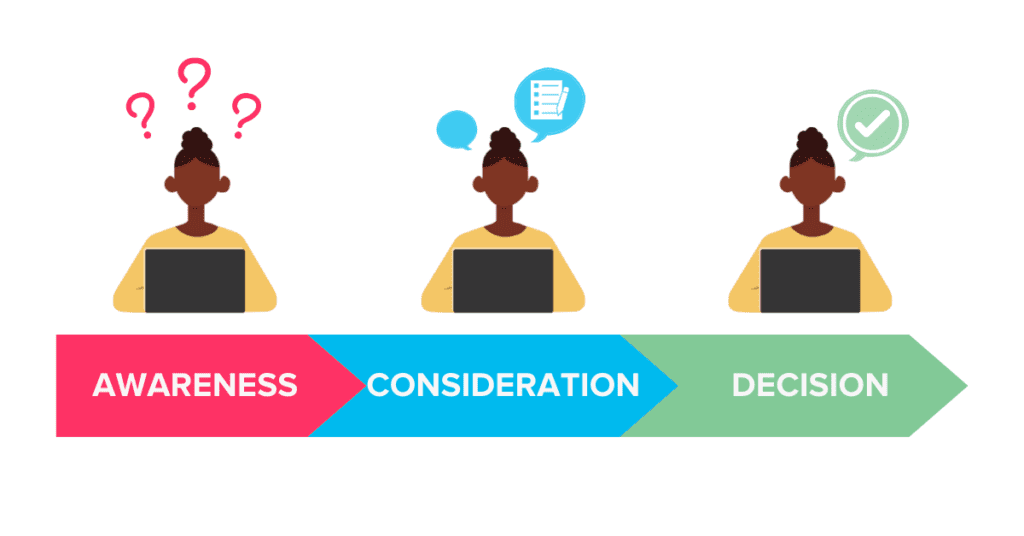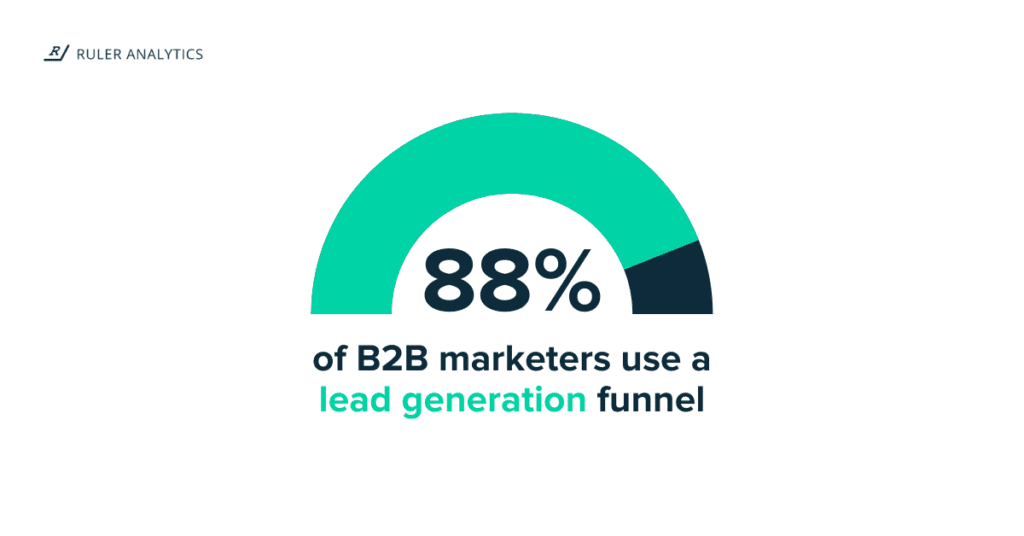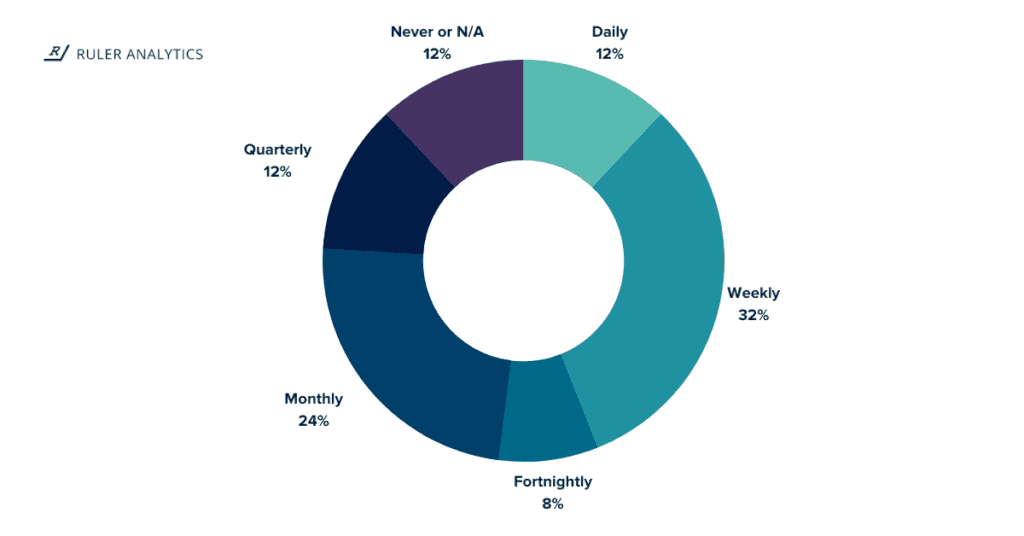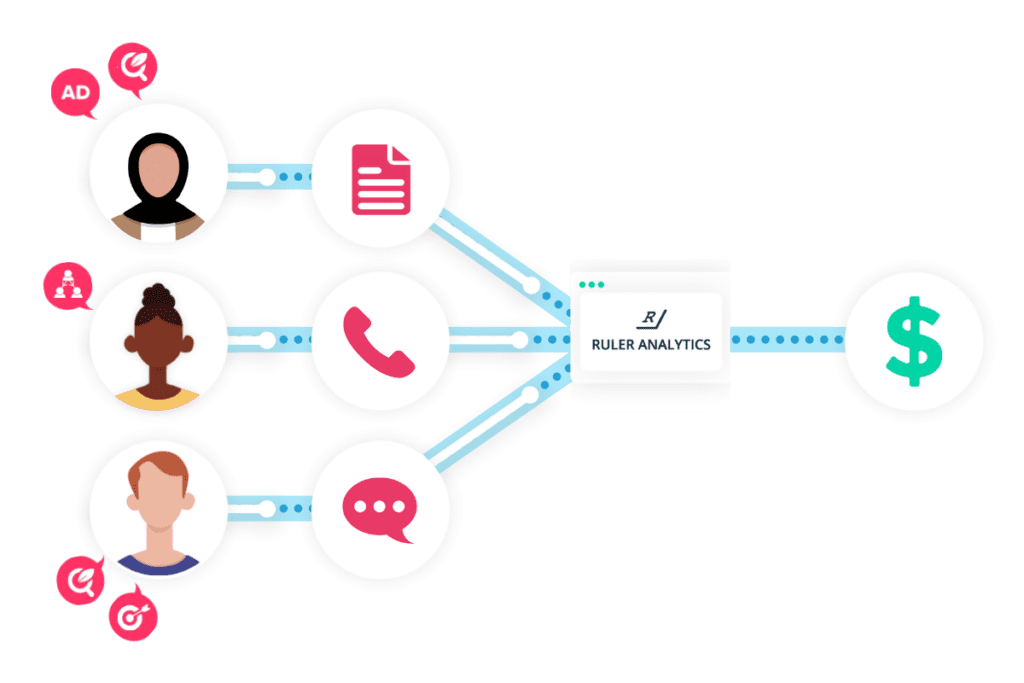The lead generation process is the engine that ensures businesses keep attracting, nurturing and converting new leads. In this blog, we’ll show you how to improve your process to increase leads and decrease wasted budget.
Lead generation is a vital part of your business plan. But you can’t just generate leads and hope that that’s enough. There’s a whole raft of steps that need to follow in order to convert those new leads into customers.
CIENCE found that 60% of businesses stated generating new customers was their biggest pain point.
Having a highly converting lead generation process means you can trust that your marketing will bring a set number of high-quality leads each month. It gives you the confidence to try new initiatives, make data-driven decisions and put budget where it matters most.
37% of marketers stated that generating high-quality leads was one of their biggest challenges.
But why are marketers struggling so much to generate the right leads?
To better understand and optimise lead quality, the first step to do is to improve your lead generation process. We spoke to experts in sales and marketing for their top tips.
Keep reading to learn:
Let’s get stuck in!
The process from lead to customer will generally look a little like this.
First, someone will discover your business through a marketing channel. That could be your blog, your social media profile or on a review site for example.

After completing their customer journey and deciding that your business looks like a good fit for them, they will convert.
This could be into a demo, a consultation call, or even an eBook.
This is where the lead generation process ends, as they’ve converted. But you shouldn’t stop tracking them here.
You now have that visitor’s contact information. At this point, that new lead will be categorised. They might be ready to hear from sales, or they might need a few more touchpoints before they’re passed onto a sales rep.
If they’re sales-ready, a sales rep will contact them and provide information on how your product or service is a good fit for them.
At this point, they might be ready to convert into an opportunity or even a sale. Understanding how your leads move through these final parts of their customer journey is vital.
While marketing mostly focuses on driving new leads, having a full view means you can properly optimise your output based on what matters most: revenue.
Having a process for working leads from the awareness stage to a sale is essential. Not only does it help your sales team convert more leads into sales, but it also helps your marketing team identify content and campaign opportunities.
Related: How to build a lead generation funnel
We spoke to marketing and sales experts about their tips for optimising a lead generation process.
We found that 88% of B2B marketers use a lead generation funnel. When leads are your lifeblood, it shows that having a formal process in place is an industry staple.

While every business will have a different process for their leads, it’s important to remember that your customers will fundamentally progress through the same basic journey.
Understanding the customer journey stages and how to track them is essential when building your lead funnel.
However, this blog is all about optimising that lead generation process.
And we found that businesses like to review their lead funnels pretty frequently! In fact, 32% of marketers said they evaluate their lead generation process on a weekly basis, while 24% said monthly.

Reviewing how your inbound leads move through your channels and content is key to understanding what’s working, and what isn’t.
But now, let’s get stuck into our expert tips on optimising your lead generation process.
We asked marketing and sales experts for their top tips when it comes to improving lead generation processes. In this section, we’ll go through the main categories that cropped up:
So, let’s get stuck in and see what they have to say when it comes to streamlining your lead process so you can drive more conversions, for less effort, money and time.
The best way to improve your lead generation process is to put more into what you know works. Perhaps a particular blog or landing page works especially well for converting high-quality leads.
Eric Carrell, Chief Marketing Advisor at SurfShark agreed, “Always keep an open mind as you pursue numerous lead-generation marketing techniques. There are many options available to you and your firm, and it’s impossible to know which one would work best for your individual circumstance until you try them out.
“Then you must study the data, make adjustments, and move forward. One of the overarching ideas to keep in mind as you go through this process is to maximize what works.
If one of your campaigns or other initiatives proves to be shockingly successful, you should be willing to put your present plans on hold and instead concentrate on this success story. Striking while the iron is hot is an important aspect of lead generation marketing.”
But how do you get that data in place?
Lead generation is difficult due to data tracking issues as leads convert offline or take months to convert into a sale.
Related: Best lead generation tools for 2021
One viable solution is to use a marketing attribution tool. Tools like Ruler Analytics allow you to link your closed revenue data back to your marketing data. This means you can see which channels, campaigns and even keywords are working hardest to drive you the most leads, and the most revenue.
💡 Pro Tip
Want to learn more about lead generation and tracking? Download our guide and see how you can get the data you need, where you need it most.
In order to double down on what works, you first need to have the data at hand to make those decisions.
Tracking the right metrics allows you to make data-driven decisions and optimise your outputs.
Emily Perez, Sales Manager at Kitchen Infinity said, “A vital tip to help improve your lead generation process would be evaluation. Making a consistent analysis of leads is essential in successfully generating sales. Routine evaluation of leads will ensure that low-producing sales months never occur again. Since evaluation allows companies to determine where leads drop off, you can implement effective strategies to resolve the problem. During this time, you can as well devise ways to recapture lost leads.”
Keeon Yazdani, Chief Marketing Officer and Elevate Delta agreed, “One tip I would recommend for improving the lead generation process is understanding the value of each subscriber and knowing your customer lifetime value. This will help you decide how aggressive you want to be in your marketing.”
Getting the right tools in place to access that data is a key step in improving your lead generation process. See which B2B marketing tools you need to consider that could help you get more out of your outputs.
Related: Read about actionable vs vanity metrics
If you want greater visibility of your leads, then a lead tracking tool is a must.
Jonathan Saeidian, founder and CEO of INITIATE.AI agreed, “It’s vital to have all of our lead sources revert into one centralized system in order to keep the leads organized, track the success and value of each lead source and ad campaign, and efficiently follow up with each lead.
Benchmarking yourself against your competitors is one thing. Benchmarking your business against itself is another.
If you know how many leads and sales you can create month on month, then you can start to predict and action growth.
Edward Mellett, Founder and Co-Founder at WikiJob.co.uk said, “In my opinion, Setting long-term goals is a terrific method to think about and understand where you want your company to go in the long run, but it doesn’t always put you on the correct path to get there.
“Examining prior outcomes to establish a benchmark is a crucial aspect of determining what your future marketing goals should be. Knowing where you’ve come from can assist you in getting to where you want to go. It’s critical to consider your past performance to make realistic expectations for how you’ll do in the future.”
When you’re assessing your lead generation process, there’s one key thing to consider.
Is your funnel built on your needs, or your customers’?
Brad Johnson, Song Production Pros said, “I’ve discovered a lot more success in my funnels when I put the emphasis on my customer and their desires/wants. At the end of the day, a customer is looking to survive and thrive. They have little interest in your history, your newsletter, your product. They want to know if you understand their problem/desire and then if they trust you to help them.
For example, if you are running an email sales funnel. Each email should be information that a customer would have gladly paid for. It should demonstrate that you are a helpful company that gets them and has the ability to help them solve their issue. That way when you do present them with an offer, it’s a no-brainer that your lead will turn into a customer.”
One way many marketers struggle to optimise their lead generation process is by chasing poor-quality leads.
Christen Costa, CEO of Gadget Review said, “Don’t be afraid to purge bad leads. If you’re running a mailing list, for example, just cull people who never interact from your list. Your lead generation process will go much smoother.”
And you can copy this process across all of your lead generation efforts. By understanding early what makes a high or low-quality lead, you can add or pull back resources from channels and campaigns that aren’t delivering.
✏️ Note
Remember, Ruler supports you to see how many leads you’re generating, and how much revenue you’re making from each marketing channel and campaign.
Hand in hand with understanding lead quality is pre-qualifying your leads. While leads generation is a numbers game, keeping quality is vital.
You can add pre-qualification to your PPC ads, your forms and your marketing copy
Randy VanderVaate, President & Owner of Funeral Funds of America said, “One way we do improve our lead generation process is by creating more detailed questions on our lead form. This helps us to better “pre-screen” our prospects to get higher intent leads. Using a longer lead form allows us to pre-qualify leads and work on leads with higher conversion rates.”
Do you know your lead conversion rate to sale? Find out how you can track your leads from start to close.
Retesting and optimising your lead generation process is key to ensuring peak conversion. We found the majority of marketers evaluate their lead generation funnel on a weekly basis (32%).
Johnny Santiago of Johnny Santiago Media added, “One tip I would share on improving your lead generation process is to also be testing the main conversion points throughout your funnel. Whether that be testing the type of content your potential prospects might be interested in, the type of lead magnets you can offer, or even the product or service you offer.”
Himanshu Shrivastava, Marketing Manager DesignBro agreed, “One tip that I would share is to constantly test your landing pages. Let me put it in this way, If you’re not testing and optimising, your competitors definitely are. It’s a prime real-estate you have and your target audience will take that next step only when they like your value proposition. Analysis of the behaviour and tweaking headlines & CTA placements accordingly will significantly improve the form fills.”
Related: 22 B2B lead generation tips from experts
Conversions are how you generate new leads. Review how your current funnel allows for lead conversion and make sure your CTAs are well-written and in the right place.
Olivia Tan, Co-Founder at CocoFax added, “One tip to improve the lead generation process is to place a CTA on every key page. Sure, your main landing page is the one where you create the most leads, but what about other pages?
Can a visitor easily drop his/her email information from every page on your site to stay in touch? If not, maybe you should consider a small sidebar CTA. The goal is to make it as easy as possible for the visitor to leave his/her personal information.”
On the topic of conversion rates, have you seen our Conversion Benchmark Report? Download it to see how you stack up to the competition. And remember, we’ve done industry-specific research too. You can find your related industry here.
Your lead generation funnel relies on your major apps talking to one another. That’s your marketing automation from your CRM and so on.
And so, keeping your lead data up to date is vital.
Related: The role of the CRM in marketing
Mark Hall, Director at Business Waste said, “Once you have the lead, don’t ruin it! Record emails and phone conversations in your sales CRM anyone who speaks to the potential customer must update the lead enquiry. No scraps of paper or knowledge in one person’s head.”
This is particularly important for ensuring that your sales and marketing teams are aligned.
Axi Patel, CMO at Raas International Clothing Inc suggested lead scoring, saying, “Rating leads enables your company to determine which leads in its database are more critical than the others. Compared to other leads, a quality lead interacts more with your company online, whether by purchasing more stuff or browsing more websites.
“You may construct a clear understanding of who your lead is and how prepared they are to buy an item by gradually profiling your leads over time. Shifting leads through the lifecycle stages of subscription to lead, marketing, and sales qualified can allow you to view your sales funnel and segment leads for improved communication targeting.”
Many marketers prescribe to pipeline marketing now as opposed to the traditional view of lead generation.
While lead generation was typically classified as marketing generating leads that were thrown over a wall to sales, end-to-end marketing allows the process to have more flow and collaboration.
Lee Grant, CEO at Wrangu said, “The lead generation process, in my opinion, is complicated and time-consuming. It can take weeks or even months for leads to turn into paying consumers.
Given lead generation frequently involves multiple departments, it can be difficult to maintain a smooth and efficient procedure. When all of the participants work together with aligned lead generation goals and a well-defined plan, however, new revenue can skyrocket. From early marketing to closed sales, lead generation funnels cover the entire range. Make a clear division and accountability between the portions overseen by the marketing and sales teams when creating your internal lead funnel. Each team understands where its responsibilities begin and the KPIs it is striving for during each stage after correctly defining and visualising the lead funnel.”
A common problem for many lead generation teams is that they’ll bring in a shed load of leads that won’t be picked up.
They might not respond to your sales team and so they sit in your CRM and get stale.
But we all know it can be cheaper to onboard an existing lead than bring in a new one. Brian Donovan, CEO, Timeshatter agreed, “Don’t forget to take care of your existing leads. This process is about more than just acquiring new leads. You have to provide products and services to your existing ones so that they stay loyal to your business. You will not experience growth if your new leads are replacing old ones.”
And there you have it. 10 great tips on how you can optimise your lead generation process. But remember, your lead funnel is unique to you. And so, the best way to arm yourself when it comes to optimising your lead generation is to get the right data in place.
Benchmarking against yourself is the best way to see how you’re improving. Here at Ruler, we look at how many leads and sales we generate. And we break it down by channel, campaign, landing page and even keywords.
It allows to get an unbiased view of what’s actually impacting our bottom line.
Read more about how Ruler attributes revenue to your marketing. Or, see the data in action by booking a demo. Remember, getting to grips with marketing attribution is the easiest way to optimise your lead generation funnel and streamline processes so that you can earn more, spend less and save time.

You’ll get definitive clarity on what truly works, and what doesn’t. So, say goodbye to masses of leads that result in zero sales and welcome in true data-driven marketing.
Learn how Ruler attributes your revenue to your marketing, or view the data in action by booking a demo.
Our team will walk you through the platform and how it can revolutionise your lead generation efforts.